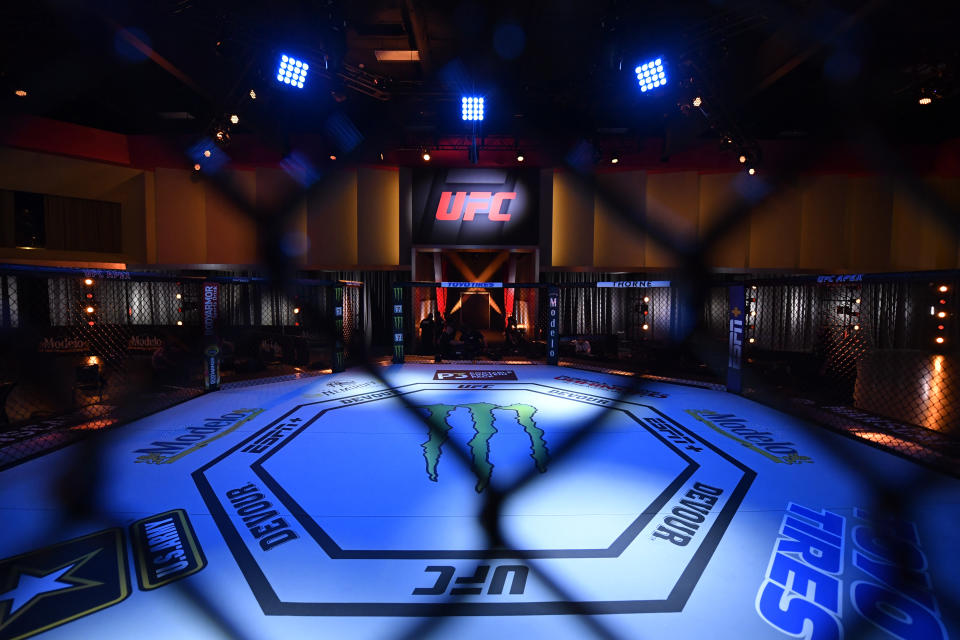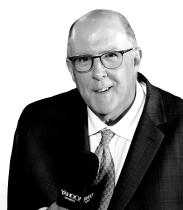Inside the UFC 250 bubble: Strict security measures contribute to safe, but strange, event
LAS VEGAS — Fear of the unknown is a real thing, which is why I had butterflies in my stomach as I started the car to head to a Holiday Inn Express across town on Saturday to prepare to cover UFC 250.
I’ve covered literally thousands of fight cards in the past four decades, but this day was like none of them.
First, the alarm went off at 5 a.m.
Because of the coronavirus pandemic, events are being held with strict security measures in place and one of the requirements for media wanting to cover them is to pass a COVID-19 test.
So I left the house a bit after 6 in the morning, a full nine hours before the first fight would end. I walked into the Holiday Inn Express to find the doors locked, and the woman on the other side pointing at me.
I’d left my mask in my car. The hotel was closed and only admitting people who were working the UFC event, but was allowing no one into the hotel without a mask. Back to my car I trudged to get it, showing my newbie status at this procedure.
I signed in with a UFC official at the front and was sent to the next station, where I got my temperature checked — 97.8, which was good to go — and filled out some paperwork. After that was quickly completed, I went into the room to get my COVID-19 test.
I was greeted by a man in a paramedic’s uniform who took my paperwork, and a man who was in full hazmat attire, including a face shield. He was the one performing my test.
As bad as I thought it may be from seeing photos on the internet, it was surprisingly easy. I had to open my mouth, say, “Ah,” and allow the technician to reach a long cotton swab to the back of my throat. It was simple, quick and easy. The technician handed my swab to the paramedic, who put it in a test tube, sealed it and confirmed my information.
Then, it was on to quarantine. To make certain it was safe, no one was allowed to leave and had to stay in a hotel room until it was time to go to the arena. I went to the front desk, was handed my key and headed to Room 104 at the end of the hall.
That was about 7:15 a.m. There was no food available, there was no room service and we weren’t allowed to leave our rooms until it was time to go to the arena. We weren’t allowed to drive separately, either; we had to climb onto a bus, with orders to take a seat one to a row and in every other row.
But I first had to wait seven hours before leaving the room. Because this was my first time, I was uncertain whether I’d hear about my results. We had been told if we were positive that we’d get further instructions. At about noon, I texted my friend, John Morgan of MMA Junkie, who had been through the procedure. I asked how we’d know if it were safe to head to the lobby.
He said if I hadn’t heard from anyone by 2:15 p.m., I was clear and it was OK to head to the lobby.
The bus made the five-minute trip to Apex, and Morgan, Arash Markazi of the Los Angeles Times and I got out at the first stop. We were the only reporters allowed in the actual venue. The others were taken to a tent that was set up in the back.

Upon arriving at the Apex, after getting another temperature check, we were taken to a room where there were meals prepared. It was my first and only meal of the day, so it was welcome.
If we left the arena for any reason, we wouldn’t be allowed back in. I didn’t think this would be much of an issue, but I had a panic during the preliminary card. More on that in a second, though.
I had been to the Apex many times, but it looked vastly different when I walked in. There were no seats set up since there would be no fans. All of the tables were maybe 25 or 30 feet from the Octagon and we were at individual tables with quite a bit of distance between us.
Little strange things occurred all night. The Octagon girls for the evening, Luciana Andrade and Brookliyn Wren, were seated to our right by themselves. When they held up the ring cards, they didn’t make the full trip around the Octagon, as they normally did.
Instead, they’d climb the steps, walk a few feet to the left and then turn around to face the camera. When it was time, a cameraman signaled them to walk toward him, maybe 10 or 15 feet. When they got down the steps, it was funny that both Andrade and Wren would fling the round card away and then have to go chase it.
Disinfecting the Octagon between bouts. #UFC250 pic.twitter.com/Cjwc2vC3Ci
— Kevin Iole (@KevinI) June 6, 2020
For a reporter, the set-up was just about perfect. I was in the center directly behind one of the corners. But I panicked when Cody Stamann won his fight. Stamann had defeated Brian Kelleher after making the difficult decision to continue to train and then to fight despite the unexpected death of his 18-year-old brother, Jacob, 10 days earlier.
After the fights, the winning fighter left the cage and went to an area where he or she was interviewed by UFC broadcaster Joe Rogan. Then, they would head to the tent to meet with the media.
I wanted to talk to Stamann to tell his story, but I panicked because I realized that I might have to leave the venue and then not be able to get back in. I texted UFC public relations head Lenee Breckenridge, who told me to meet her in the lobby. She’d bring Stamann to me before he went to the media tent.
So I sat at a table doing an emotional interview with Stamann. I told him I’d lost my younger brother, Keith, at a young age and we talked about that as I interviewed him. All the while, Ian Heinisch was fighting Gerald Meerschaert while we were chatting and I missed the quick knockout.
From where we were seated, we couldn’t really hear the announcers, but we could definitely hear punches and kicks connect. I grimaced several times as I heard that unmistakable thwack. As long as I have done this, I always cringe when someone gets hit with a big, clean shot. It was that much tougher to deal with on Saturday given the added benefit of hearing it and not just seeing it.
When the main event ended with Amanda Nunes retaining her featherweight title in a dominant unanimous decision over Felicia Spencer, I had to write my early story. This is typically a shorter one that I normally do that I try to get in to my editor within 10 minutes of the announcement of the result. Normally, there are other reporters cageside doing this same thing.
But as I was writing, I noticed everyone had left and I was by myself. On this night, I needed to film a quick video, as well. So I had to stay longer before a UFC PR person escorted me to the tent for the news conference.
When UFC president Dana White showed up at the tent, it dawned on me that it was the first time that night I’d seen him in person. White doesn’t want to wear a mask and one of the Nevada Athletic Commission’s rules was to have a mask on at all times in the arena area.
It was a normal news conference, except that there was a microphone at every seat so it was kind of difficult to know whose turn it was to ask. Normally, a staffer passes a microphone around, but to be careful, this time everyone had a mic.
We left the venue a little after midnight and I got home a little before 1 a.m., which is a bit earlier than I do on most UFC pay-per-view shows.
All in all it was a simple experience. It was easy to do my job. I felt safe and there were no unnecessary restrictions.
Nothing can be guaranteed to be 100 percent safe, but it seemed to be as safe as possible and I was fine with all of the steps we had to take.
More from Yahoo Sports:



